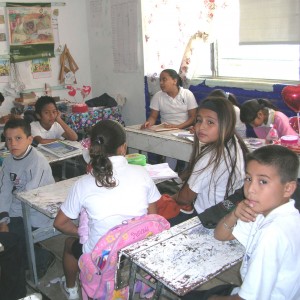
Building English Language Confidence in Children
- Posted by Daisy Stocker
- Date August 30, 2015
- Comments 0 comment

Building Confidence in Children Learning English as a Second Language
Let’s assume you’re teaching rhyming words to your Children’s ESL EFL class. Some of the children are interested in your rhyming words lesson but others aren’t participating. Perhaps they are shy, frightened or unfamiliar with some of the sounds. It’s important to understand why many English Second Language children feel frightened and insecure, but it’s more important to find a way to help them. This article discusses why some might be having difficulty participating and suggests some types of activities that could help them.
Why Do ESL Children New to an English Speaking Culture Have Difficulty Participating?
These students often have trouble understanding the language used by other kids on the playground, so they tend to withdraw from group participation. Perhaps they are confused about the behavior of the other children because they don’t understand the way the others react to different situations.
Why Do Some Children Living in Their First Language Environment Withdraw or Act-out in an English Foreign Language Class?
These children may reject learning a language different from the one spoken in their community. One child commented: “I don’t want to talk funny”.
They have no knowledge of what their future needs might be. It is understandable for them to want to cling to the language and culture that they know.
Suggestions for Helping Children New to an English Speaking Culture or Those Learning English in Their First Language Environment.
 Drawing:
Drawing:
For shy or frightened children with very little English, give them a small drawing assignment where oral language isn’t required. They should remain sitting with the rest of the group you are teaching. This removes the pressure for them to understand and speak, but they are hearing the lesson, they are still a part of the group and perhaps they understand some of it. They will want to be like the other children and they will participate more and more if their small attempts are recognized and they receive lots of teacher encouragement.
Songs and Verses:
At the pre-teen level these can be repeated many times. Songs are easy to remember. Students who have difficulty participating can sing with the rest of the group. Young shy or frightened students will enjoy participating in action songs or verses. It is important, however, that for the ten, eleven and twelve-year-olds, the choice of songs is what the other students consider to be “cool”.
These are another effective way of helping children to speak. At first they can take a puppet’s role by speaking in unison with another child. As they gain confidence they will be able to speak for the puppet by themselves. For the child, it’s the puppet that’s talking, so the fear of making a mistake is minimized.
Every classroom group is different. Try any or all of these suggestions and adapt them to your style of teaching. If they help even one student in your classroom to feel more confident, then any changes you have made have been worthwhile.
Tips for Building Confidence
- Create a Supportive Environment: ESL classrooms should be a safe and supportive place so children feel comfortable speaking English and making mistakes.
- Set Realistic Goals: Every goal and milestone achieved is a boost to confidence. If goals are not achievable, it has the opposite effect. Break larger objectives into smaller, do-able tasks.
- Catch them doing it Right: Feedback that is specific and constructive focusing on students’ strengths builds confidence. Addressing areas for improvement in a kind and supportive way. Reinforce effort, progress and accomplishments. Create frequent opportunities for students to succeed with speaking, listening, reading, and writing.
- Encourage Active Participation: Encourage participation from all students with frequent activities, discussions, and exercises. Encourage students to share thoughts, ideas, and experiences in English. Interactive and hands-on activities such as games, role-plays, storytelling, and group projects
- Be Confident: You are the role model for confidence and a positive attitude in English. Show your enthusiasm and passion for teaching English. After all, if you aren’t enthusiastic, how can you expect them to be?
Teaching Children ESL Articles
- Teaching the English Alphabet to Children - Books -- Songs -- Teaching Alphabet Elements -- Names and Sounds -- Uppercase and Lowercase -- Shapes and Sounds Teach letter names in lowercase and uppercase. This helps children recognize and familiarize themselves with the …
- Children’s Learning Problems and Suggestions for Helping Them - Wherever you are teaching, it’s likely that you have one or two children who disrupt the class or are withdrawn from the group. These students require extra teacher time. They …
- Tips for Building Confidence in Young Children - Let’s assume you’re teaching rhyming words to your ESL class. Some of the children are interested in your rhyming words lesson but others aren’t participating. Perhaps they are shy, frightened …
- Motivating Young Children to Learn English - Motivating Children in Difficulty or Boring SubjectsLet’s assume that the children have had time to settle into the classroom environment and that you are ready for them to begin the …
- Get Kids Interested and Excited About Learning English - English Foreign Language classes can accelerate learning if they offer exciting stories for the children to enjoy. People of all ages need to be interested in what they are studying. …
- Developing Listening Comprehension in Children - If English Second language children are interested and actively involved in what they are doing, they will learn to understand English. This article will present a type of activity that …
- Building English Language Confidence in Children - Let’s assume you’re teaching rhyming words to your Children’s ESL EFL class. Some of the children are interested in your rhyming words lesson but others aren’t participating. Perhaps they are …
- Choosing a Children’s ESL Curriculum - The first thing that one has to realize when faced with a class of ESL children is that they are not short adults, they are something entirely different. Teaching ESL …
- Suggestions for Cutting Costs in Providing Your Children’s ESL Curriculum - The world has entered a period of difficult times. Millions of people have lost their jobs, companies that have had many years of success are closing their doors and people …
Date Published: 2015-08-30
Date Modified: 2024-04-24
Daisy Stocker taught ESL in Eastern Europe for 10 years and was a primary school teacher in Canada for 30 years. Daisy has a B.A. and M Ed. in Education.
You may also like
Teaching the English Alphabet to Children
Books — Songs — Teaching Alphabet Elements — Names and Sounds — Uppercase and Lowercase — Shapes and Sounds Teach letter names in lowercase and uppercase. This helps children recognize and familiarize themselves with the …
Wherever you are teaching, it’s likely that you have one or two children who disrupt the class or are withdrawn from the group. These students require extra teacher time. They …
Tips for Building Confidence in Young Children
Let’s assume you’re teaching rhyming words to your ESL class. Some of the children are interested in your rhyming words lesson but others aren’t participating. Perhaps they are shy, frightened …
